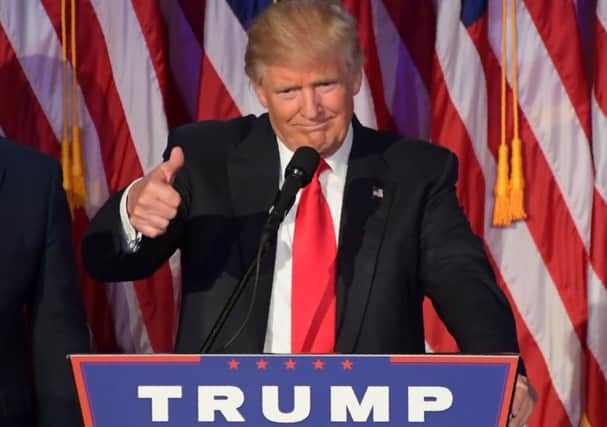How Donald Trump won the US election


That dynamic was amplified by the peculiar mathematics of the Electoral College, which gave a megaphone to less-educated voters in the Midwest.
A look at the building blocks of Trump’s win over Hillary Clinton:
WORKING-CLASS WOES
Advertisement
Hide AdAdvertisement
Hide AdThese voters spoke with a shout, particularly in Rust Belt states that have mostly favoured Democrats in recent elections. Noncollege-educated whites made up about a third of the electorate nationally, but they accounted for more than 4 in 10 voters in Wisconsin, Pennsylvania and Ohio and made up fully half of all voters in Iowa. In all four states, and nationally too, the margin by which Trump won noncollege whites surpassed Mitt Romney’s margins in 2012. Nationwide, some 67 percent of these working-class voters backed Trump, attracted to his insurgent’s pledge to upend the status quo.
Trump’s strong support among those with less than a college education is at least partly a reflection of how little the economic recovery since the Great Recession has benefited them. Their job opportunities have dwindled and their incomes have fallen, even as broader measures of the nation’s job market show improvement. Middle-aged white men with only high school degrees - the core of Trump’s support - saw their inflation-adjusted incomes plummet 9 percent from 1996 through 2014, according to Sentier Research, a data analytics firm founded by former Census Bureau officials.
RURAL OOMPH
Democratic candidates have long worked to stockpile votes in urban centers to offset the more conservative electorate in America’s small towns and rural areas. A colour-coded map of the 2016 results - a sea of Republican red in the country’s midsection with blue states largely arrayed along the two coasts - amply illustrates the rural/urban divide. Clinton won about 6 out of 10 votes in cities with more than 50,000 residents; Trump won about 60 percent of votes in small towns and rural areas. Voters in the suburbs largely split their votes between Clinton and Trump.
But Trump made some crucial inroads. He won Pennsylvania, for example, by toppling a 20-year-old Democratic maxim to build an insurmountable lead in Philadelphia and its suburbs. Clinton did build an impressive lead in Philadelphia and its suburbs, surpassing Barack Obama’s showing there in 2012, but Trump swamped Clinton in the rest of the state. The last time Pennsylvania voted for a Republican for president was 1988.
RACIAL POLARISATION
The white vote has shrunk in recent years - from about 80 percent in 1996 to 70 percent of Tuesday’s vote - but that’s still a powerful number. Trump dominated with whites no matter how you dice their votes - among men and women, young and old, college-educated and noncollege-educated. That diluted the potency of Clinton’s strong performance with Hispanics and blacks.
In North Carolina, where Trump won by a 4-point margin, the race was decided less on Clinton’s failure than on Trump’s unanticipated success. Clinton’s campaign had hoped African Americans would make up 20 percent of the electorate, and they did. Nine in 10 blacks supported the Democrat. But Trump’s strength with white, rural and small-town voters overwhelmed her support among blacks.
Likewise, in Florida, where Trump won by just over 1 percentage point, Hispanics favored Clinton by almost a 2-to-1 margin and nearly 9 in 10 blacks backed her. But their outsized support for her was swamped by Trump’s 2-to-1 lead among white voters, who made up more than 60 percent of the electorate.
AGE MATTERS
Millennials came through for Clinton, but one lesson of the 2016 election was the older voters still pack a punch. Some 55 percent of the electorate is 45 or older.
Advertisement
Hide AdAdvertisement
Hide AdClinton got her most intense support from voters who are 18 to 29, winning more than half of that group. Her support dropped among older voters, winning about 45 percent among voters older than 45. That percentage held for the Democratic nominee among voters who are least 65.
For Trump, the trend was reversed. He won a little more than a third of the youngest voters and captured a majority of voters older than 45.
ELECTORAL COLLEGE
In the end, it didn’t matter that Clinton was on track to win more popular votes than Trump nationally: Her voters were too geographically concentrated to save her where it mattered most, in battleground states that tipped to Trump by small margins to produce a lopsided victory in electoral votes.
With three states too close to call, Trump led Clinton 279-228 in electoral votes. In the popular vote, Clinton was leading 47.7 percent to 47.5 percent, or by about 236,000 votes.
Trump pulled out victories in North Carolina, Pennsylvania, Wisconsin and Florida by the narrowest of margins, yet collected 74 electoral votes from them, or more than a quarter of the 270 votes needed to win the presidency.
